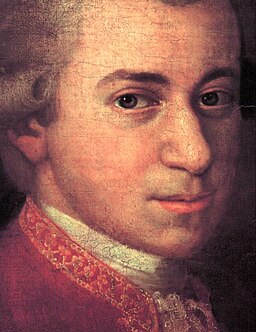 What is it about the greatest music that keeps us coming back? Mozart’s music, written in an era of powdered wigs and aristocracy, speaks to us as powerfully today as when it was written over 250 years ago. It embodies a universal reality which transcends fashion and style. Meanwhile, Antonio Salieri (1750-1825), a respected contemporary of Mozart, is now little more than a historical curiosity.
What is it about the greatest music that keeps us coming back? Mozart’s music, written in an era of powdered wigs and aristocracy, speaks to us as powerfully today as when it was written over 250 years ago. It embodies a universal reality which transcends fashion and style. Meanwhile, Antonio Salieri (1750-1825), a respected contemporary of Mozart, is now little more than a historical curiosity.
You may remember this scene from the 1984 movie, Amadeus in which Salieri laments his mediocrity when compared to Mozart’s genius. Along the way to the film’s powerful and thought provoking themes, the real Salieri gets a bum rap. In reality Salieri represents most of us. He never poisoned Mozart. He was actually an excellent composer, firmly in control of his craft. Towards the end of his life he taught several young students whose names you might recognize: Beethoven, Liszt and Schubert. But where Salieri’s music ended in good craftsmanship, Mozart’s continued with that extra “something” which is hard to define…perfection and inspiration on a different level. Its source is a mystery. Mozart was able to tap into the highest level of “hearing.”
Consider Shakespeare, Michelangelo, Picasso and Einstein and you find the same level of inspiration at work. “God is in the details.” said the great twentieth century architect, Mies van der Rohe. As an architecture buff, I was fascinated to discover that Mies, who designed New York’s famous Seagram Building, elevated something as mundane and utilitarian as a gas station to high art. Can you identify what sets this gas station apart from millions of others? Is it the materials and sense of proportion?
Gas stations aside, let’s listen to two piano concertos, one by Salieri and the other by Mozart. Here is Salieri’s highly enjoyable Piano Concerto in C Major performed by Heeguin Kim and the Amadeus Chamber Orchestra. There are three movements: Allegro Maestoso, Larghetto (8:51) and Andatino (15:58).
Now, here is Mozart’s Piano Concerto No. 12 in A Major, K. 414. The performance is by Murray Perahia and the English Chamber Orchestra. The movements are Allegro, Andante (10:31) and Allegretto (18:50):
Think about what you just heard. What makes Mozart’s concerto so extraordinary? What sets it apart from the Salieri? Share your thoughts in the thread below. Also, what music from our time do you think will endure? Don’t worry too much about the last question because it’s almost impossible to know how music will withstand the test of time. At one time J.S. Bach’s music was considered outdated and only useful as a source of study.
As musicians we’re challenged to open up our ears and imaginations, “hear” the music as clearly as Mozart did and let the musical vision come to life. It’s a nearly impossible task, but one we must strive to fulfill every day.
[button link=”https://itunes.apple.com/us/album/mozart-the-piano-concertos/id394314313″]Find on iTunes[/button] [button link=”http://www.amazon.com/Mozart-Piano-Concertos-Nos-And/dp/B000QQUZTE”]Find on Amazon[/button]
